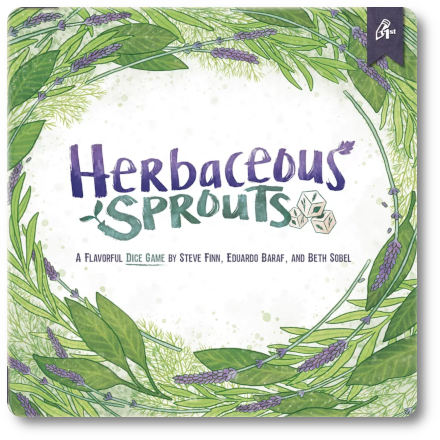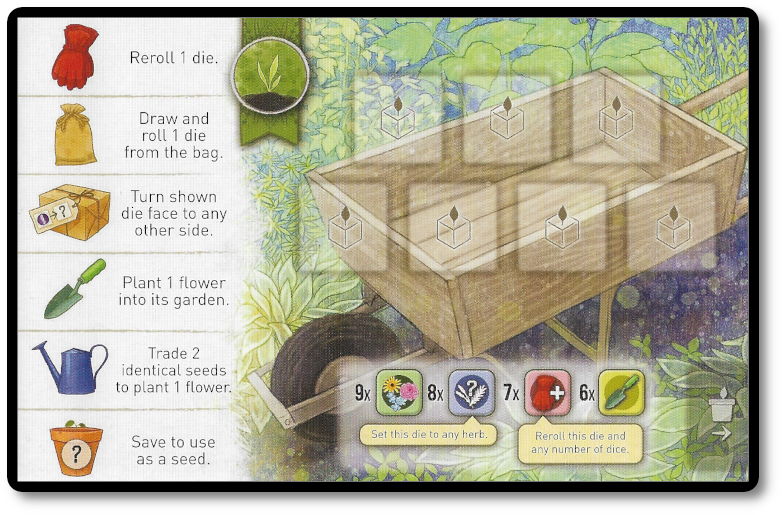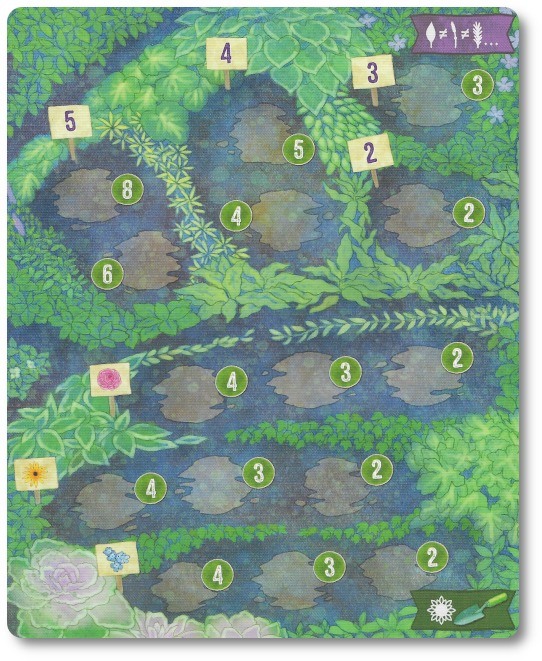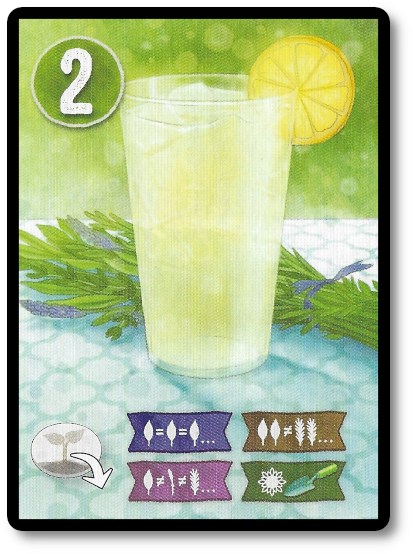 The Basics:
The Basics:
- For ages 8 and up
- For 1 to 4 players
- Approximately 30 minutes to complete
Geek Skills:
- Active Listening & Communication
- Counting & Math
- Logical & Critical Decision Making
- Pattern/Color Matching
- Strategy & Tactics
- Risk vs. Reward
- Hand/Resource Management
Learning Curve:
- Child – Easy
- Adult – Easy
Theme & Narrative:
- Control the growth of a community garden, one seed at a time
Endorsements:
- Gamer Geek approved!
- Parent Geek approved!
- Child Geek approved!
Overview
A community garden is a shared place of peace and growth where anyone can try to plant seeds and turn the earth. In this game, you will share a community garden with friends and family, each wanting to plant sprouts and flowers to create a rich and beautiful garden full of life and color. Unfortunately, there is only so much space to be had. Get your gardening tools at the ready and collect your seed packets! You have limited time and space to plant something extraordinary and win the game.
Herbaceous Sprouts, designed by Eduardo Baraf, Steve Finn, Keith Matejka and published by Pencil First Games, is comprised of one gameboard, 40 Tool cards, 30 Seed dice (custom six-sided dice), one Lemonade card, eight Bonus Information cards, four Wheelbarrow mats, 60 Player Sprout tokens (in four player colors), 20 Rival Sprout tokens, one Seed Dice bag, and four Reference cards. The cardboard components are thick and durable, the wooden bits are solid, and everything else you can point to is top quality in this game. A nice touch and addition to the game that does not contribute to the gameplay itself are the Bonus cards that feature the artwork of Beth Sobel who did an outstanding job of making the game colorful and pleasing to the eye. Each Bonus card summarizes the herbs and flowers in the game, giving the player additional knowledge – and appreciation – for what they are planting in the game’s garden.
Getting Ready to Garden
To set up the game, complete the following steps:
First, place the gameboard in the middle of the playing area and within easy reach of all the players. The gameboard represents the garden where players plant sprouts to dominate specific garden plots.
Second, give each player a Wheelbarrow mat in the color of their choice and the matching colored 15 Sprout tokens. Players should place their Wheelbarrow mat and Sprout tokens in front of them. Each player should take a Reference card at this time, as well. The Wheelbarrow mat will serve as the player’s staging area, and doubles-up has a handy reference for the Tools used in the game.
Third, put all the Seed dice into the Seed Dice bag and give it a shake to distribute the dice randomly. Have each player draw two dice from the bag randomly and roll them. The rolled result should be placed – with the result side face-up – in one of the seven open square spaces found on the player’s Wheelbarrow mat. These represent the player’s starting sprouts and possibly tools.
Fourth, shuffle the Tool cards. Depending on the number of players, you might need to remove a specific number of cards randomly. These removed cards should be placed back in the game box without looking at them. Any remaining Tool cards should be placed face-down to create the Tool draw deck.
Fifth, take the Rival Sprout tokens and place them near the gameboard if playing with two or three players. The Rival Sprout tokens may be placed back in the game box if playing with four players.
Sixth, and finally, place the Lemonade Card off to one side of the game-playing area.
This completes the game setup. Determine who will go first and begin. Give this person the Seed Dice bag.
Have fun in your garden!
Digging Into the Game
Herbaceous Sprouts is played in rounds and turns with a specific number of rounds per game based on the number of players. A game round is summarized here.
Phase One: Prepare the Tool Shed
The player with the Seed Bag – known as the “Lead Gardner” – will draw several cards from the Tool draw deck equal to one greater than the number of players in the game. For example, the Lead Gardner would draw five Tool cards in a four-player game. The drawn cards are placed face-up in a row to create the “Tool Shed.”
After placing the cards, the Lead Gardner determines how many dice need to be drawn from the Seed Dice bag. The number needed is shown on the Tool card using empty squares. The Lead Gardner draws one Seed dice for each square, rolls it, and places it on the square space. This step is repeated until all the Tool cards that need a die has the required number placed. Note that some Tool cards do not have a space for a die and will not receive one during this game phase.

If there are not enough dice to roll, each player must return one of their dice of their choice to the Seed Dice bag. This is repeated as many times as necessary to ensure each of the Tool cards in the Tool Shed has the required number of dice for the round.
Phase Two: Players Pick and Plant Seeds
In turn order sequence, starting with the Lead Gardner, each player will complete four sequential steps in the order summarized here.
Step One: Select One Tool Card
The current active player selects one available Tool card in the Tool Shed. The player can perform the associated action for each tool shown on the Tool card. The player’s Wheelbarrow mat and Reference card provide all the details needed to understand what the tools can do to assist them.
Step Two: Fill the Wheelbarrow
If the Tool card selected has dice on them, the player must take them (without losing their previously rolled value) and place them in a space on their Wheelbarrow mat. Each Wheelbarrow mat can contain a maximum of seven dice. A player may remove a previously placed die to make room for the new die. Any dice that cannot be placed or the player does not want to place is returned to the Seed Dice bag.

Step Three: Use Tools and Special Dice
The player may use the tools indicated on their selected Tool card if the tool action allows them to take it immediately. A player is never forced to resolve a tool action. The same goes for any dice that have a tool shown.
Seed dice used for their special action are returned to the Seed Dice bag. Tool cards used for their special action are discarded unless the Tool card displays a “Sprout Pot.” These cards are attached to the player’s Wheelbarrow mat and now represent that herb or flower type as shown. Essentially, this gives the player more to plant with, but they are still limited to a maximum number of seven Seed dice. If the noted sprout is used, the Tool card is discarded.
Step Four: Plant Herbs and Seeds (and Possibly Get that Tall Glass of Lemonade)
The player may now optionally plant herbs and flowers in the community garden but, again, is never forced to.
The gameboard separates the community garden space into four sections. Each section requires a certain number and pattern of herbs or a flower. Patterns include:
- All the same herb
- All different herbs
- Matching pairs of herbs
In addition to the needed number of herbs, there is also a plotted spot in the garden space that contains a number in a white box and numbers in a green circle. The number in the white box indicates the number required to plant. The number in the green circle represents the points earned for successfully planting.

If the player can provide the needed number of herbs using their Seed Dice and Sprout Pots, they take a Sprout token of their color and place it in the plot with the highest number value that is not already taken. The player has now scored that number of points. The player may continue to plant herbs as many times as they like.
The flower plots are used in the same fashion but require the player to have the matching flower type and a “Trowel” tool, or they can use a “Watering Can” tool to trade in any two identical dice to plant one flower. Similarly to planting herbs, the player takes a Sprout token and places it in the highest available number in a green circle that matches the planted flower.
After planting, the player should evaluate how much of the community garden they occupy. If they are the first player to occupy at least one plot in each of the four areas of the community garden, they are awarded the Lemonade card, which provides the player bonus points at the end of the game. Yum! Refreshing!

This completes the player’s turn. Any Tool cards not saved for their “Sprout Pot” should be discarded now.
The next player in the turn order sequence now takes their turn, starting with step one noted above.
Phase 3: Clean Up
After all the players have completed their turn, it’s time to set the gameboard for the next round.
If playing with two or three players, you must first determine where the “Rival Gardener” will plant their Sprout token. This is done by looking at the remaining Tool card not selected by the players during their turn. The card will show where the Rival Gardner Sprout token will be placed. If a Sprout token already occupies that plot, no action is taken. If the Sprout is placed, it always occupies the green circle with the greatest value.
It should also be noted that if the Rival Gardner is the first to plant a Sprout token in each of the four areas of the community garden, the Lemonade card is discarded.
Finally, return any Seed dice still on the unused Tool card to the Seed Dice bag and discard the unused Tool card. The Seed Dice bag is then passed to the next player in turn order sequence, who becomes the Lead Gardner for the next round.
Leaving the Garden and Final Score
The game continues until the last of the Tool cards are placed face-up. The round is finished as usual, and the game ends after the clean-up phase.
Players now count their points. This is done by adding the number values in the green circles next to their Sprout tokens. Players score additional points for unused Seed dice and Sprout Pots. Each die and Sprout Pot can only be used once to score points.
- Two points for each set of three different herbs
- One point for each pair of matching herbs
- One point for each flower
And finally, the player who has the Lemonade card scores two bonus points.
Once all the players add up their scores, the player with the highest score wins the game.
Game Variant
While we will always strongly suggest that games are best played with family and friends, there are times when we want to play a great game (like Herbaceous Sprouts), but we don’t have anyone to play the game with. No worries, the game has you covered with rules that allow the player to go head-to-head with the Rival Gardener (controlled by cards) in a race to be crowned the new king (or queen) of the community garden. In the single-player variant of the game, the player takes on the role of Master Gardner and their Assistant. Gameplay is largely the same, with the game variant cards dictating some actions customarily determined by the player.
To learn more about Herbaceous Sprouts, visit the game’s web page.
Final Word
 The Child Geeks had no issues learning to play the game and eagerly jumped into the garden to get their hands in the dirt. The game is colorful and attracts the eye. This and the fast gameplay kept our littlest gamer geeks engaged from start to finish. According to one Child Geek, “The game is really easy to learn and fun to play. I liked how I got to pick and choose where I wanted to plant. It doesn’t feel good when someone takes your spot before you do, but you always have a place to plant.” Another Child Geek said, “This reminds me of when I go out in the garden with Mom and help her plant vegetables and flowers, but a lot less messy and a lot more fun!” When the last sprout was lovingly planted, the Child Geeks took stock and found that Herbaceous Sprouts was a lot of fun.
The Child Geeks had no issues learning to play the game and eagerly jumped into the garden to get their hands in the dirt. The game is colorful and attracts the eye. This and the fast gameplay kept our littlest gamer geeks engaged from start to finish. According to one Child Geek, “The game is really easy to learn and fun to play. I liked how I got to pick and choose where I wanted to plant. It doesn’t feel good when someone takes your spot before you do, but you always have a place to plant.” Another Child Geek said, “This reminds me of when I go out in the garden with Mom and help her plant vegetables and flowers, but a lot less messy and a lot more fun!” When the last sprout was lovingly planted, the Child Geeks took stock and found that Herbaceous Sprouts was a lot of fun.
 The Parent Geeks, always looking for an engaging and casual game to play with family and friends, immediately fell in love with Herbaceous Sprouts. According to one Parent Geek, “I was concerned that this game would be just a dice version of Herbaceous, but it isn’t. It has the same theme, but the narrative and gameplay are very different, giving you two enjoyable gaming experiences.” Another Parent Geek said, “Excellent game. It has just the right amount of random seeding (no pun intended), player interaction, and decision-making to make each round and player’s turn meaningful. I greatly enjoyed myself and found the game to be just as entertaining with my kids and my friends.” When the last tools were put away in the shed, the Parent Geeks evaluated their garden and found it well worth their time.
The Parent Geeks, always looking for an engaging and casual game to play with family and friends, immediately fell in love with Herbaceous Sprouts. According to one Parent Geek, “I was concerned that this game would be just a dice version of Herbaceous, but it isn’t. It has the same theme, but the narrative and gameplay are very different, giving you two enjoyable gaming experiences.” Another Parent Geek said, “Excellent game. It has just the right amount of random seeding (no pun intended), player interaction, and decision-making to make each round and player’s turn meaningful. I greatly enjoyed myself and found the game to be just as entertaining with my kids and my friends.” When the last tools were put away in the shed, the Parent Geeks evaluated their garden and found it well worth their time.
 The Gamer Geeks, who do not normally go in for causal games, found Herbaceous Sprouts to be just casual enough to keep things light but with enough decision-making and competition to rule the garden to make it engaging enough to keep their elitist’s minds fixated on the prize. According to one Gamer Geek, “Make no mistake, this is a casual game, but it’s also very charming. I found each of my turns to be appropriately empowered by the decisions I needed to make, correctly impacted by my opponents, and the options dwindled in a fashion I found appropriate to the gameplay itself. It’s fast and on point. I enjoyed it and would play it again as a game filler.” Another Gamer Geek said, “Beautiful and peaceful to play, with an undercurrent that most certainly hooked my competitive nature. I enjoyed it and found the gameplay to be just the right mix of engaging casual gameplay for someone who wants to compete but not in a fashion that feels heavy or cutthroat.” When the Rival Gardner was kicked out, the Gamer Geeks took a deep sip of the Lemonade, finding the game very satisfying.
The Gamer Geeks, who do not normally go in for causal games, found Herbaceous Sprouts to be just casual enough to keep things light but with enough decision-making and competition to rule the garden to make it engaging enough to keep their elitist’s minds fixated on the prize. According to one Gamer Geek, “Make no mistake, this is a casual game, but it’s also very charming. I found each of my turns to be appropriately empowered by the decisions I needed to make, correctly impacted by my opponents, and the options dwindled in a fashion I found appropriate to the gameplay itself. It’s fast and on point. I enjoyed it and would play it again as a game filler.” Another Gamer Geek said, “Beautiful and peaceful to play, with an undercurrent that most certainly hooked my competitive nature. I enjoyed it and found the gameplay to be just the right mix of engaging casual gameplay for someone who wants to compete but not in a fashion that feels heavy or cutthroat.” When the Rival Gardner was kicked out, the Gamer Geeks took a deep sip of the Lemonade, finding the game very satisfying.
 Interestingly, our gaming elitists found the original game from which Herbaceous Sprouts derives its title (Herbaceous) to be a “take it or leave it” gaming experience. The introduction of dice and limited availability, along with player selection and resource management, was enough to make the Gamer Geeks sit up straight, take notice, and get into the game with just the same amount of enthusiasm as their Parent Geek and Child Geek counterparts. Best of all, a Gamer Geek – while most certainly more skilled than every Child Geek we play with and most of our Parent Geeks – found that they had to work just as hard, make the same number of tough choices, and make the same mistakes as everyone they played with. The game’s rules keep everyone on the same level without limiting gameplay or enjoyment. Truly excellent.
Interestingly, our gaming elitists found the original game from which Herbaceous Sprouts derives its title (Herbaceous) to be a “take it or leave it” gaming experience. The introduction of dice and limited availability, along with player selection and resource management, was enough to make the Gamer Geeks sit up straight, take notice, and get into the game with just the same amount of enthusiasm as their Parent Geek and Child Geek counterparts. Best of all, a Gamer Geek – while most certainly more skilled than every Child Geek we play with and most of our Parent Geeks – found that they had to work just as hard, make the same number of tough choices, and make the same mistakes as everyone they played with. The game’s rules keep everyone on the same level without limiting gameplay or enjoyment. Truly excellent.
I have now played Herbaceous Sprouts more times than I care to count and find it always to be a game I welcome back to my table. As noted, the gameplay is fast, the choices are fascinating, and the limitations keep everyone just enough on edge to keep everyone leaning in until the very end. All of our games are close, and not once did we ever feel that one player was getting too far ahead or left too far behind. The result was a game enjoyed by all and continues to be enjoyed.
I highly recommend Herbaceous Sprouts. Play it when you can to determine if it grows on you.
This game was given to Father Geek as a review copy. Father Geek was not paid, bribed, wined, dined, or threatened in vain hopes of influencing this review. Such is the statuesque and legendary integrity of Father Geek.



